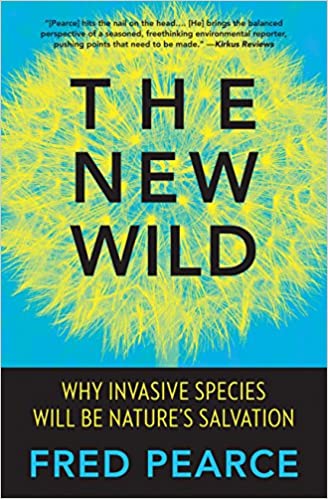
THE NEW WILD; WHY INVASIVE SPECIES WILL BE NATURE’S SALVATION.
Nancy Ironside’s take:
Ecologists are divided into 2 groups- those who fight the Invasives with all the time and money available, and those who accept the inevitable and think nature and mankind will cope. The second group consider the fight hopeless (Sisyphean), and I belong to the second group. So, when I see a book that supports my opinions, I naturally choose this book.
Fred Pearce, the author and journalist, is based in London, England, but he has reported on environmental science from 85 countries over the last 20 years. This book was published in 2015.
The orthodoxy in conservation is that aliens are bad, natives are good. The new thinking considers that keeping out aliens may weaken nature rather than strengthen it. We need a new wild, one which is very different from the old. We have changed our planet too much, and nature can never go backward. Thousands of introduced species may die out, or they may become part of the new ecosystem increasing the biodiversity.
The new species may be nature’s best chance of surviving the damage done by human activity, by pollution or by climate change.
We are comfortable with what we know and love, but we live in a world that is a mixture of alien and native, where nothing is pristine but is a result of years of disturbed ecosystems. But nature is blossoming in many damaged ecosystems that had already been wrecked by humans.
Opening the Suez Canal allowed tropical species to move into the Mediterranean. 250 species of all kinds established themselves, and there was only one recorded extinction. Similarly, when the Panama Canal joined the Pacific and Atlantic Oceans, biodiversity increased on both sides. North America has more bird and mammal species than when the Europeans first landed.
Unexpected consequences may result in attempts to control alien species- whether it is shooting reindeer in South Georgia Island, killing Ruddy Ducks in Spain, farming in the Everglades, or purging 68 species of alien trees in South Africa. Our efforts in Ontario to control garlic mustard and other invasives are so minor in comparison that we are never mentioned in the book.
References to scientific papers take 26 pages of fine print -interesting reading if you doubt his tales.
It is worth reading the book to see the fascinating stories he tells.
Ron Reid’s take:
Nancy warned me that I would hate this book. She was partly right, but more so I found it challenging, for it head-on challenges much of the orthodoxy I absorbed in my career as a biologist. The author brings forward enough examples from around the world to make a reasonable case that the introduction of non-native species can increase biodiversity in some cases, and that a lot of the efforts put forward to remove those invasives is wasted.
But many of his claims seem over-blown. For example, one of the experts he quotes claims that there is no such thing as “virgin” ecosystems left in the world; all of them have been modified by human actions in the past. That may well be true in Britain and other long-settled regions, but what about the boreal forest, for example?
Part of my discomfort with this book is that it over-simplifies the term “biodiversity”; Pearce basically treats it as a numbers game. In his eyes, if the introduction of non-native species ups the count, that is all that matters. A dominant species like Sugar Maple in our local woodlands could be reduced by 95% by an invasive, but it still counts as present, so no harm done. If you replace a habitat specialist, such as Pileated Woodpecker, with an alien generalist like European Starling, the count is even. But the basis of biodiversity is how species and genomes interact within communities, not just a simple present/absent count.
The book argues that rather than worrying about new species, we should welcome them – the more, the merrier. Pearce seems to go out of his way to tweak the noses of conservation biologists, suggesting that there is no proof that global biodiversity even matters, and that most conservation activities are a waste of time.
By Pearce’s brutal calculation, we should sit back and allow Dog-strangling Vine to overtake the unique habitats on the Carden Alvar, because it is ecologically stronger. Any attempt to keep this alien in check is “coddling” threatened species which deserve to die out under its assault. Maybe so, but in my mind some ecosystems warrant all the coddling we can muster.
Pearce is a good story-teller and reading this book may make you question some long-held assumptions about how we save nature. But bring a critical lens to your reading before you accept that invasive species will be nature’s salvation.
The book is available to purchase on line, new or used.
It is also available in electronic form at the Orillia Public Library.
